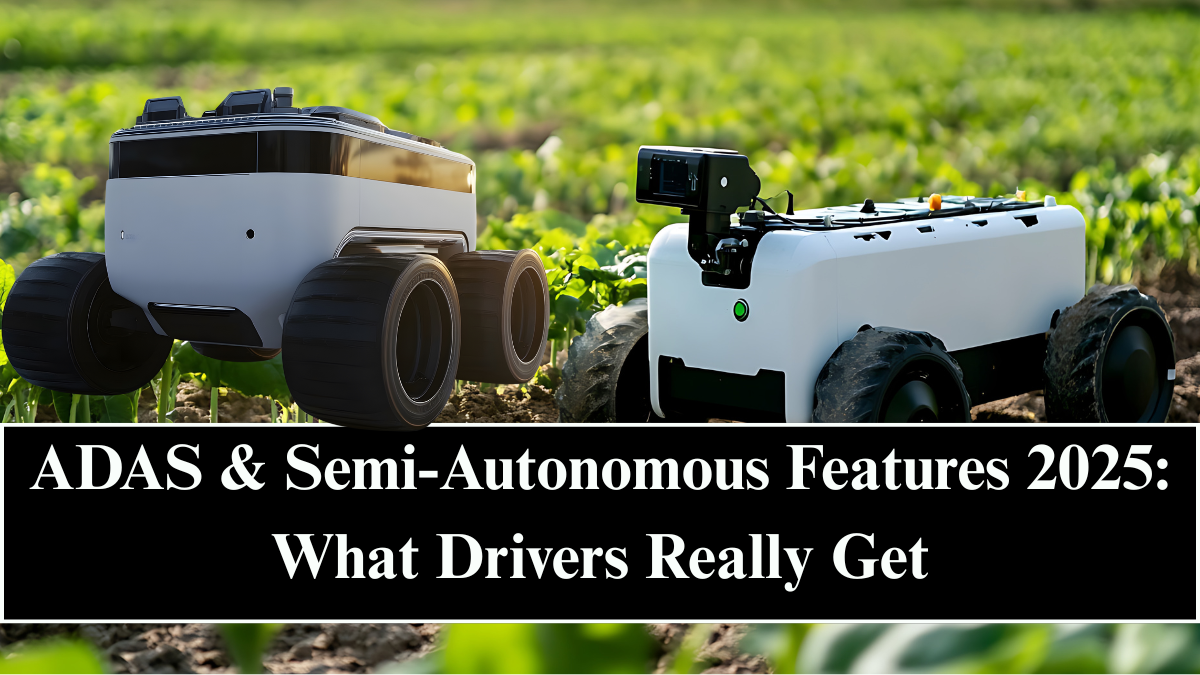The year 2025 marks a major leap forward in vehicle automation and safety technology. Advanced Driver Assistance Systems (ADAS) and semi-autonomous features have become mainstream across most modern vehicles — not just luxury cars. These systems use a combination of sensors, cameras, radar, and artificial intelligence to make driving safer, smoother, and more efficient.
From lane-keeping to adaptive cruise control and automated parking, these innovations are shaping a new era of intelligent mobility — one where cars think, react, and protect better than ever before.

Understanding ADAS and Semi-Autonomous Driving
ADAS (Advanced Driver Assistance Systems) are technologies designed to assist drivers in making better decisions and avoiding accidents. They form the foundation for semi-autonomous driving, where vehicles can take partial control under certain conditions.
By 2025, most cars offer Level 2 or Level 2+ autonomy, where the car can manage steering, acceleration, and braking — but still requires human oversight.
Core ADAS systems include:
-
Adaptive Cruise Control (ACC): Automatically maintains speed and distance from the vehicle ahead.
-
Lane Keeping Assist (LKA): Detects lane markings and prevents unintentional drifting.
-
Blind Spot Detection: Monitors areas invisible to the driver’s mirrors.
-
Automatic Emergency Braking (AEB): Prevents or mitigates collisions through sensor-based braking.
-
Traffic Sign Recognition (TSR): Reads and displays road signs in real-time.
Together, these systems have reduced collision rates by up to 40% compared to vehicles without them.
The Evolution of Vehicle Automation in 2025
Automation is no longer futuristic — it’s here, integrated into everyday cars. In 2025, semi-autonomous features have evolved from luxury add-ons to safety essentials. Automakers are deploying AI-powered systems capable of contextual awareness, meaning they can interpret complex driving environments in real-time.
The global automotive landscape now includes:
-
Level 2+ vehicles that handle highway driving almost independently.
-
AI-assisted parking systems that can park without driver input.
-
Autonomous emergency response functions, automatically stopping cars after detecting health anomalies (like driver drowsiness).
-
Predictive obstacle detection, identifying hazards seconds before human perception.
These advancements have made 2025 a pivotal year for automotive intelligence and road safety.
Leading Automakers and Innovations
Top manufacturers are competing to make ADAS and semi-autonomous systems more accessible and intuitive.
-
Tesla: Constantly refining its Autopilot and Full Self-Driving (FSD) features with OTA updates.
-
Mercedes-Benz: Offering Level 3 Drive Pilot approved for public highways in select countries.
-
BMW and Audi: Combining lidar, radar, and camera fusion for next-gen highway assist systems.
-
Hyundai and Kia: Equipping mid-range models with highway and parking automation at affordable prices.
-
Volvo: Prioritizing safety-first automation, introducing the Ride Pilot feature in its EV lineup.
These companies are proving that automation and accessibility can coexist, making intelligent safety technology available to all drivers.
AI and Sensor Fusion Technology
The backbone of modern ADAS lies in AI-powered sensor fusion, where data from multiple sensors (cameras, radar, and lidar) is combined to form a precise, real-time 3D model of the vehicle’s surroundings.
Key components include:
-
Cameras: Provide visual data for lane, sign, and object detection.
-
Radar sensors: Measure speed and distance, essential for adaptive cruise control.
-
Lidar systems: Use lasers to map the environment in high detail.
-
Ultrasonic sensors: Aid in parking and close-range navigation.
-
AI processors: Analyze incoming data, make predictions, and issue corrective commands.
These technologies allow vehicles to “see” 360 degrees, even in low visibility conditions, ensuring driver confidence and enhanced road awareness.
Benefits of ADAS and Semi-Autonomous Systems
The adoption of ADAS technology in 2025 is bringing clear, measurable benefits to drivers, passengers, and pedestrians alike.
-
Improved Safety: Real-time alerts and automatic corrections drastically reduce accidents.
-
Lower Driver Fatigue: Long trips become less stressful with automation handling repetitive tasks.
-
Fuel Efficiency: Optimized driving behavior saves energy and fuel.
-
Accessibility: Helps elderly or differently-abled drivers maintain mobility independence.
-
Insurance Incentives: Vehicles equipped with ADAS often qualify for lower insurance premiums.
As vehicles grow smarter, these features are not just conveniences—they’re lifesaving technologies shaping the next generation of transportation safety.
Challenges and Limitations
Despite their progress, ADAS and semi-autonomous systems are still evolving. Key challenges in 2025 include:
-
Regulatory differences between countries delaying higher-level autonomy adoption.
-
Weather and visibility issues affecting sensor accuracy.
-
Driver complacency, where over-reliance on automation can create new risks.
-
Infrastructure gaps, especially in regions lacking well-marked roads.
Automakers are tackling these issues through redundant sensors, AI fail-safes, and driver monitoring systems that ensure continuous attention behind the wheel.
The Future: From Semi to Fully Autonomous Driving
The next frontier is full autonomy — Level 4 and Level 5 driving, where cars can operate without human input under most conditions. By 2030, these systems are expected to be widespread in urban areas, logistics fleets, and shared mobility services.
Upcoming trends include:
-
AI neural networks capable of predicting complex traffic scenarios.
-
Vehicle-to-Everything (V2X) communication linking cars, pedestrians, and infrastructure.
-
Autonomous lane switching and overtaking without driver involvement.
-
Integration with smart cities, enabling coordinated traffic flow and energy management.
These innovations will transform vehicles into cooperative, self-learning mobility systems, minimizing human error and maximizing safety.
FAQs
What is ADAS in cars?
ADAS stands for Advanced Driver Assistance Systems, a suite of technologies that help drivers with tasks like braking, steering, and collision avoidance.
How autonomous are cars in 2025?
Most vehicles now feature Level 2 to Level 2+ automation, meaning they can drive semi-independently but still require driver supervision.
Are ADAS features available in affordable cars?
Yes, brands like Hyundai, Kia, and Toyota offer ADAS in mid-range and even entry-level models.
What sensors power ADAS systems?
ADAS relies on camera, radar, lidar, and ultrasonic sensors working together to monitor surroundings in real time.
Will cars become fully autonomous soon?
By 2030, we can expect Level 4 and Level 5 autonomous vehicles to operate in smart cities and commercial fleets, enabling truly driverless travel.
Click here to know more.
